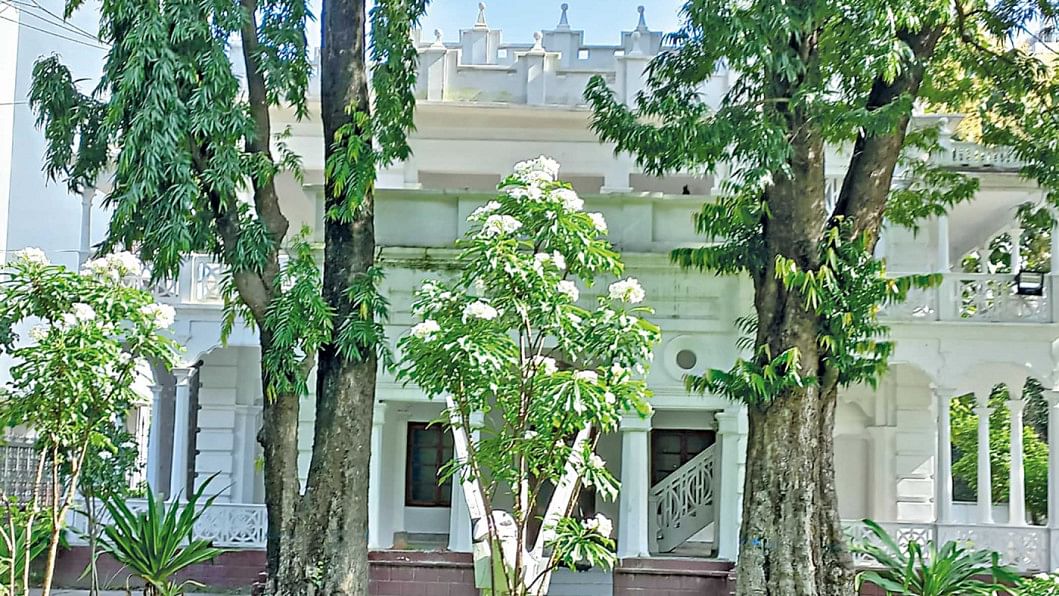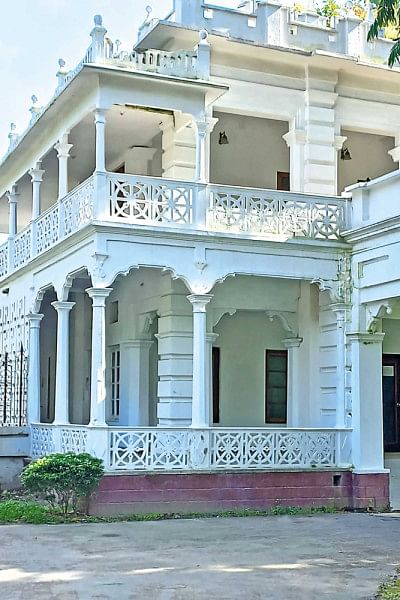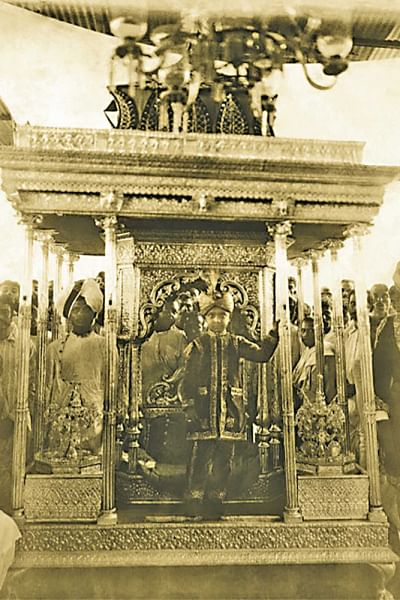Legacy of the Kumar of Bhawal


Prior to the abolition of Zamindari in East Bengal (Bangladesh) in accordance with the 'East Bengal State Acquisition and Tenancy Act of 1950', the Bhawal zamindar estate was the second largest feudal landholding in the Dhaka district. In terms of size (area), revenue and prestige it was second only to the Dhaka Nawab estate of the Khawja family. In fact, its enormous landholdings within Dhaka city began right from today's Bangla Motor, embracing much of Tejgaon, going all the way up to Savar and beyond. Most of the land to the north of the city fell under the Bhawal estate. In the early 1960s, on our way to school in the Dhaka cantonment area, we had to regularly pass by an attractive period building with a large pond where stork, heron, kingfisher, kite, duck and geese frolicked. The attractive old building stood on the opposite side of the former Dhaka airport at Tejgaon. This unique historic edifice looked somewhat incongruous in its setting, ensconced as it was amidst a picturesque setting redolent in luxuriant foliage, thereby attracting my attention and curiosity. There was no other comparable, large and impressive colonial era mansion like it anywhere around, unless one went all the way to the Ramna area of Dhaka city. One day, I asked my driver to stop by this old two-storied building ringed by huge old banyan, neem and rain trees of crowning glory for a good look. This eye-catching mansion was once the Baganbari or pleasure-villa of the Bhawal zamindar. Built in 1933, it is called the Nymph which was built by Kumar Ram Narayan Roy on a sprawling twenty bighas of land. I had never heard of this Kumar of Bhawal before. The information was given to me by a Hindu gardener of the horticulture department who was then working at the site. His forefathers had all been malis (gardners) of the Bhawal zamindars. As I wandered around in the vast pristine compound of the Nymph, a gentle spring breeze swayed the branches, boughs and rustled the leaves of the ancient trees. The blissful quietude of the sylvan surroundings seemed to cast a entrancing spell, as I savored the languorous ambience of the place. Little did I known then that come nightfall this peaceful place, was said to be occasionally haunted by the ghost of a young woman clad in a diaphanous white sari. The most macabre part of the story was that the ghost carried her severed head in her own hands!

My subsequent visits later on to the Nymph left me a bit baffled regarding its hybrid architectural styles and antecedents. Therefore, I sought the wise counsel of a distinguished veteran architect Abu H. Imamuddin, requesting him to take a look at some photographs of the Nymph, I had passed on to him and enlighten us by describing its salient architectural features. He most graciously obliged and wrote, "Just by observing the building without any knowledge of its original plan, makes it difficult to provide an accurate architectural assessment of it. However, in brief here is a general impression of the building. It seems that the building underwent a number of alterations and modifications over time, corresponding to the changes of ownership and the need for functional usage. The weak relationship of the inner and the outer façade is distinctly visible. The inner façade resembles the architecture of the British colonial era that flourished in Dhaka after the partition of Bengal. There are massive corner columns with decorative arches. However, the outer façade looks like a latter addition having eclectic architectural characteristics. The repetitive motifs on the railings in the outer verandah may have been adapted from the Bungalow design, atypical of the mansions of the local landlords of that period. On the roof, the dwarf towers with a dome on top represent two different religious references: Christian and Islamic. The parapets around the roof having a regular undulating pattern with projected pillars topped by spherical heads, represents a common recurring feature in the design of the colonial bungalow. The curious screen wall shown having a vertical slab built with pinwheel designed blocks, may have been placed much later for some specific functional need. The pattern of the design suggests that it is of a latter addition to the building. The overall complex architectural taxonomy of the building makes it hard to classify it into any specific category".
Now a brief on the Bhawal Raj, the second Kumar, the Sannyasi, and the most celebrated judicial court case in the history of the British Raj in colonial India. The zamindar Raja Bahadur Rajendra Narayan Roy Chaudhuri of Bhawal died in 1901, leaving behind his widow, Rani Bilashmani Devi, and six children—three daughters: Indumayi, Jyotirmayi and Tarinmayi and three sons: Ranendra alias baro (eldest) Kumar, Ramendra alias mejho (second) Kumar and Rabindra alias sejho (youngest) Kumar. In 1904, citing gross mismanagement, the Bhawal estate was taken over by the Court of Wards. Meanwhile, the nationalist quarters and the vernacular print media in Bengal raised a big 'hue and cry' at the forcible takeover of one of the premier zamindar estates of East Bengal. Meanwhile, a great tragedy descended upon the Bhawal Raj family. Rani Bilasmani died in 1907, of illness. In 1909, the second Kumar suddenly died in Darjeeling, amongst conflicting reports that he was both cremated and also that his dead body had mysteriously vanished from the cremation grounds during a sudden thunder shower, before being consigned to the flames. The matter would have ended there. But soon there arose unsubstantiated charges of a palace conspiracy and dark nefarious family politics were hinted at. It was further alleged that the Kumar was poisoned by his own wife, Srimati Bibhabati Devi, in connivance with her secret paramour the family doctor. Soon strange news of a wandering Sannyasi resembling the lost Kumar also started to emanate from various parts of India, complicating the already fluid situation. To make matters worse, the eldest Kumar also died in 1910, probably as a consequence of his excessive drinking habit, followed by the death of the youngest Kumar in 1913. All three Kumar's had died childless. The Bhawal Raj was now bereft of any legitimate male heir to the zamindari. In 1915, the Court of Wards under the Board of Revenue, went into action again and took over the management of the estate. Thus, the stage was set for a confrontation which would increasingly take on a fervently patriotic, nationalistic and anti-colonial overtone against the British Raj in support of the beleaguered Bhawal Raj.
However, powerful factions within the Bhawal Raj family coalesced to reverse the situation in their own favor. In this the widow of the youngest deceased Kumar, Srimati Ananda Kumari Devi, played a pivotal role. She adopted a boy, Ram Narayan Roy, as the new Kumar of Bhawal. Surprisingly, contrary to their negative policy against the Bhawal zamindar estate, this move was endorsed by the British Raj as evidenced from a rare photograph where the Earl of Ronaldshay, Governor of Bengal on his visit to Dhaka in 1919, had himself 'anointed' the boy-Kumar's eventual assumption to the 'guddi'(throne) of Bhawal as the heir-apparent and possibly later as the Raja. However, all this would dramatically change the scenario with the miraculous appearance of a strange Sannyasi, naked except for a loincloth, smeared in ash and long matted hair, on the Buckland Bund near the Ruplal House in Dhaka in 1921. He bore a striking resemblance to the missing second Kumar of Bhawal. For months he refused to identify himself. In the meantime, his advent had aroused great curiosity and speculation. Later on, during his subsequent visits to the Bhawal Rajbari, the Sannyasi was hugely welcomed and recognized by the tenant-farmers as their second Kumar. The tenants thronged in record numbers to the palace premises and started paying him his share of the rent, even before he was lawfully declared as the lost Kumar. Thereafter, supported by a powerful faction of the Bhawal raj family, thousands of tenant-farmers, sympathetic public and media, the Sannyasi finally changed his stance. He claimed that he was indeed the lost Kumar of Bhawal who being poisoned by his own family, was saved by a group of Naga Sadhus who had nursed him back to health. In the meantime, he had wandered all these years throughout India with the Sadhus having lost his memory, until his arrival in Dhaka. Through all this unfolding high drama the widow of the second Kumar, Srimati Bibhabati Debi, adamantly refused to meet the Sannyasi declaring him as an interloper. However, the biggest loser from this sensational development would be, Srimati Ananda Kumari Debi, the widow of Rabindra the youngest of the deceased Kumar's, her adopted son Kumar Ram Narayan Roy who was the 'heir-apparent' to the Guddi of the Bhawal zamindari, and the palace coterie that had staunchly supported them.
At last, on April 24, 1930, lawyers working for the claimant (Sannyasi), supported by the sisters and elder sister-in-law of the Kumar, filed a declaratory lawsuit in the court of the first sub-judge of Dhaka district, claiming the name and property of Ramendra Narayan Roy against his widow Bibhabati Debi and other shareholders who were represented by the Court of Wards. The trial began on November 30, 1933. Both sides summoned an over abundance of witnesses (literally hundreds), whose statements were often contradictory. However, judgment was delivered on behalf of the plaintiff the Sannyasi in 1936.
On October 5, 1936, the government filed an appeal against the judgment of the lower court in the Calcutta High Court, again in the name of the wards of the Court of Wards. The hearing began on August 14, 1939. On November 25, 1940, the Calcutta High Court upheld the verdict and the appeal was dismissed. In 1943, the colonial government in consultation with the lawyers representing Rani Bibhabati then filed for a leave to appeal against the judgment of the Calcutta High Court in the Privy Council in London seeking redress. However, the war and the German blitz in London delayed the hearing which finally began in 1945. After a prolonged hearing, the Privy Council in London also dismissed the appeal in its judgment in favor of the Sannyasi, on July 30, 1946.The next evening the claimant (Sannyasi) finally declared lawfully as the second Kumar of Bhawal went to offer puja at a Kali temple in Calcutta, where he suffered a stroke and died two days later. His funeral rites were preformed on August 13, 1946. Divine retribution for an imposter? That is exactly what Srimati Bibhabati Devi and those of her ilk concluded.
Through this protracted Bhawal Sannyasi case, the deprived and frustrated Kumar Ram Narayan Roy grew into manhood as a tall, heavyset, fair and handsome young man, devoted wholesale to a life of indolence and pleasure. As a privileged feudal in those days, he became drawn to a hedonistic lifestyle of - shikar, musical soiree, cavorting with dancing girls (baijee/tawaif), given to binge drinking and spending endless nights of sensual pleasure with his companions. To give proper vent to his amorous proclivities, he built an exclusive pleasure villa in 1933, called the Nymph at Tejgaon away from the prying eyes of his family and the din and bustle of the Bhawal palace at Joydebpur. However, it is not known if Kumar Ram Narayan eventually regained his short-lived rights as the sole heir to the Bhawal zamindari until its abolition in 1950, on the sudden death of the Sannyasi in 1946, declared as the rightful second Kumar of Bhawal. After the abolition of zamindari in 1950, following the partition of British India in 1947, the huge landed property including the Nymph of the Bhawal zamindars was taken over by the Dhaka Cantonment Board, and handed over first to the Pakistan Air Force and after 1971, to the Bangladesh Air Force (BAF) to be used as their Officers Club and mess. At present it is used as the BAF Ladies Club. Sadly, the beautiful large pond which once lent so much glamour to the adjacent Nymph, has now been mindlessly filled up and turned into a big lush green airy field for recreational purpose for the BAF personnel and their families.

And, as for the mysterious lady ghost at the Nymph, only a few air force personnel during both the Pakistani and Bangladeshi periods had ever claimed that they had indeed seen it. But for those overwhelming majority of people who only heard of it, but never saw nor believed in it, conclude with a 'wink and a chuckle' that it was fabricated by someone in a fit of drunken stupor at the bar, whose fervid imagination had given currency to it. However, the story persists to this day. The Nymph is the only remnant of a zamindar era Baganbari (garden-house) from the colonial days in Dhaka city. It has miraculously survived the vicissitudes of time and escaped the greed of men due to its fortuitous location in the cantonment area, thereby remaining well preserved. However, regretfully nobody knows what really happened to all those expensive chandelier, candelabra, furniture, rich Persian carpet/rug, monogrammed cutlery pieces and decorative artifact that had once graced the interior of the many roomed Nymph! We, therefore, urge the concerned authorities of the Bangladesh Air Force to take moral responsibility and ensure that this wonderful heritage building remains unaltered. The Nymph will soon turn a 100 years old in 2033, besides being an unique historical mansion with a story to tell. It should be declared a heritage building to be preserved for posterity. Meanwhile, it remains one of the best kept secrets in Dhaka city!
In 2004, I was told an interesting story by a prominent member of the erstwhile Dhaka Nawab family. She narrated that as a young school girl in the early 1950s, she had once espied with wide-eyed wonderment from an upper floor window of her house in Dhaka, the fairytale visage of a beautiful stately carriage (Brougham) driven by two handsome horses, as it slowly came up the driveway to her house. She had run down bubbling with excitement to welcome the august visitor. The carriage door was emblazoned with a gorgeous family crest. Soon an imposing figure - a large, fair, immaculately attired aristocratic gentleman emerged from the carriage. Hugely impressed and in awe, she welcomed him with courteous regard, introduced herself and politely ushered the guest into the living room. With an affectionate pat on her head the visitor said in a rich baritone voice,"go tell your father that his friend Ram Narayan Roy is here to see him". It was the same little Kumar of Bhawal shown here in the picture. The storyteller, now a distinguished elderly lady further added wistfully that her father and the Kumar of Bhawal, had been childhood friends and were of the same age.
My heartfelt thanks to the following retired Bangladesh Air Force Officers for most graciously sharing their interesting reminiscences and photographs of the Nymph: Air Vice Marshal A.G. Mahmud, Group Captain M. Shaukat-Ul Islam and Air Commodore Ishfaq Ilahi Choudhury.
Waqar A Khan is the Founder of the Bangladesh Forum for Heritage Studies.

 For all latest news, follow The Daily Star's Google News channel.
For all latest news, follow The Daily Star's Google News channel. 



Comments